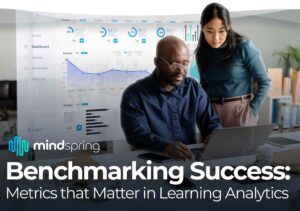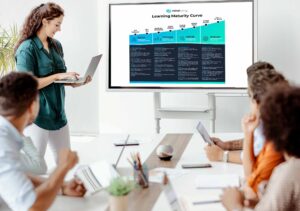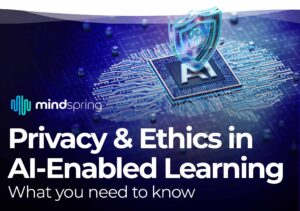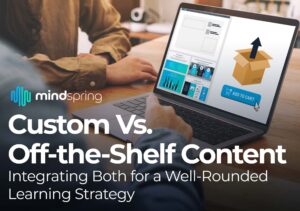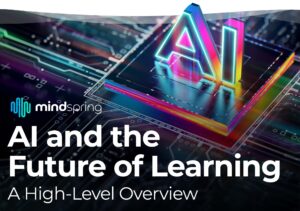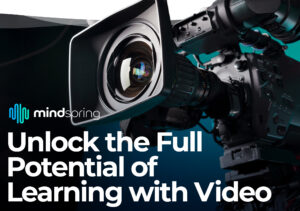Story Introduction
Kathryn is the Chief Learning Officer at a fictional manufacturing company called AshCom, located in Minneapolis. Kathryn has been the CLO for more than five years and, with her team, has produced some amazing learning experiences. But things are changing fast. Rebecca is a consultant from MindSpring who has served as an advisor to Kathryn for the last four years. This is their story.
“Are you ready to talk about something other than finances?” asked Rebecca.
“Please, yes!” replied Kathryn.
Kathryn served as the CLO of AshCom, a manufacturing company located in Minneapolis with 7,000 employees. She was under significant pressure. Learning outcomes had been declining for months in the midst of company-wide poor financial performance. A hiring freeze was the first announcement from leadership. A few weeks later, layoffs began.
Kathryn began the year with a learning team of ten people. It was now down to seven. One of her highly skilled experience designers left when the hiring freeze was announced. Two others were part of the layoffs, a decision Kathryn had to make. For the first time since she became the Chief Learning Officer at AshCom, Kathryn was considering a career change.
Kathryn needed an outsider’s opinion on how to guide her team. More than an opinion, Kathryn was looking for insight and wisdom. Rebecca had been helpful in other circumstances and it was Kathryn’s hope that she would be again.
Rebecca kicked off their time together by writing on a whiteboard what she called the Twelve Essential Questions:
- What are your top company priorities right now and how will learning play a pivotal role in achieving them?
- Who are the targeted learners and how well do you know them?
- Do your learners care about learning and how does learning connect with their goals?
- What organizational factors are influencing your learning initiatives?
- How will get your learners’ attention and build momentum for learning?
- What are the essential topics for learners right now, what is their order, and is everyone aligned?
- How are you measuring the impact of learning on your organization?
- How are you keeping current or ahead of the curve in the learning industry?
- How are you upskilling your learning team?
- How will you meet your objectives without adding full time team members?
- What is your 3–5-year plan for learning in your company?
Kathryn and Rebecca had already covered several of the questions. Those were hard discussions given all that was going on at AshCom.
Their previous conversation had been especially challenging because it focused on how to demonstrate the financial impact of learning at AshCom. Kathryn felt least prepared for that conversation. How, exactly, could someone in her position point precisely to the return on investment for the learning budget? With Rebecca as a guide, Kathryn developed a plan that would help her defend her learning budget and show that learning was essential for getting AshCom back on solid financial footing.
The topic of their next discussion was much closer to Kathryn’s comfort zone. Together they would try to answer the question: How are you keeping current or ahead of the curve in the learning industry? Rebecca knew Kathryn and knew she would be energized by the conversation.
“I assume you’re happy to move past the financial question,” said Rebecca.
‘You’re correct,” said Kathryn with a broad smile. “This is much more in my wheelhouse. But first I have a question about the question.”
“Fire away,” replied Rebecca.
“Are you asking,” inquired Kathryn, “how I am personally staying ahead of the curve in the learning industry, or are you asking how my team is doing?”
“I suppose I’m asking about both,” said Rebecca. “Despite all the financial challenges at AshCom right now, there’s something we haven’t discussed much yet that needs some attention. When you initially called me to come in and spend some time with you, you mentioned that your learning results were declining. Fewer people were seeking out learning or recommending learning to others. Scores on knowledge checks were declining, and learner ratings for courses were not where they used to be.”
“All of that’s true,” said Kathryn. “My learning team tracks these metrics and feels like they’re failing. The loss of three of our ten team members didn’t help morale either. My team feels overwhelmed by their workload and at the same time feels like they’re not doing enough to improve both learning experiences and our financial position in the company.”
“Do you think the team feels learning is declining because of the hiring freeze and layoffs you’ve seen in the last few months?” asked Rebecca.
“Of course,” responded Kathryn, “but they also think something else is going on. They wonder if their work is getting stale.”
“Let me ask you a question,” said Rebecca, “and I need complete honesty in your answer. Take a minute to think about it if you need to. If AshCom were not struggling financially, and the overall company culture was stronger, do you think your learning performance metrics would still be declining?”
Kathryn didn’t hesitate. She didn’t need a moment to think about it. “Yes,” she replied. “We were seeing a slow decline even before the financial challenges. I would say the cash problem, the hiring freeze, and the layoffs sped up the decline, but I saw it happening before any of those things started.”
“Clearly you’ve been thinking about this for a while,” said Rebecca.
“I have been,” said Kathryn, “but in the middle of the mess we have right now, and with three people gone from the learning team, I didn’t think it was the right moment to bring it up. My team is already under stress, and piling on seemed like a bad idea.”
“I certainly don’t want to add to their anxiety,” said Rebecca, “or give them the sense that they’re part of the problem. Instead, I’d like to help you and your team think of this as an opportunity to retool what you’re doing.”
“You mean upskilling,” said Kathryn.
You’re saying our team makes a specialized product that helps other people, but we aren’t able to take advantage of that help ourselves.
“I do,” said Rebecca. “Think about it. People in learning talk a lot about upskilling learners as working from home becomes more common and technology continues to advance. But we don’t talk much about how to upskill the people building the learning experiences.”
“So it’s like the old Spanish proverb?” asked Kathryn.
“Can’t say I know what you mean,” said Rebecca, raising an eyebrow.
“Sure you do,” said Kathryn smiling. “There’s an old Spanish proverb, ‘En casa del herrero, azadón de palo,’ which roughly translates into the English saying, ‘The cobbler’s children always go barefoot.’ You’re saying our team makes a specialized product that helps other people, but we aren’t able to take advantage of that help ourselves.”
Rebecca chuckled. “First, nice pronunciation! I had no idea you knew Spanish. Second, you could have made that a lot easier if you’d just said ‘cobbler’s children.’ I would have gotten the reference immediately.”
“My head is full of odds and ends like that,” said Kathryn, “and I’m constantly looking for an opportunity to use them. So what you’re saying is that my team, who’s responsible for learning at AshCom, is not learning very well itself.”
“I think that’s what you’re saying, actually” replied Rebecca, “but that deficiency certainly isn’t unusual among people who work in L&D.”
“It seems like only a few years ago,” said Kathryn, “that we were on the cutting edge of learning. We were rolling out better learning experiences through games and microlearning and blended learning. Our learners had deep appreciation for the time and effort we were putting in because the experiences were engaging, gave them what they needed when they needed it, and made good use of new technology.”
“Let’s focus on what you just said and see if we can identify some causes,” replied Rebecca. “It could be that your team’s passion for learning is not where it should be, so they’re not putting in a full effort.”
Kathryn thought for several seconds and said, “I know the last months have been hard on my team, and people in tough situations often don’t do their best work. That’s understandable. But I don’t think my team members have lost their passion for learning.”
“That’s encouraging,” said Rebecca, “because that’s one of the most difficult problems to fix. Let’s assume they remain highly passionate about learning. Let’s talk about the tools available to them. Have you explored or introduced any new tools in the last year or two? Is it your sense that they’re making the most of the tools they have?”
“We haven’t introduced new tools lately,” replied Kathryn, “and I can tell you that we haven’t even spent much time looking for new authoring tools. As far as fully using the tools we have, I suspect my team might be in a bit of a rut. We’re doing what we’ve always done because we know how to do it and we’re efficient.”
“Efficient is good,” said Rebecca, “but efficiency can become the enemy of creativity. Sometimes we do what we know without realizing there might be a better way.”
“I get what you’re saying,” said Kathryn. “Repetition helps the people who are making the experiences go faster and produce more content, but it doesn’t do much for learners. If everything looks, sounds, and feels the same, we’ll undoubtedly lose people’s attention. Sometimes it seems like we’re in the entertainment business and all that anyone cares about is the next new thing. It feels like an ever-receding horizon that we never can meet.”
How do we keep learning science at our core while being creative and making innovative use of old and new technologies?
“We might not like it, but it’s our reality,” said Rebecca as she stood up and wrote “More Creative” on Kathryn’s whiteboard.
“Let’s talk about tools,” continued Rebecca. “Technology is changing our industry. This has been true for decades, but the pace of technical change is coming at us faster all the time. Interactive video, 3D modeling, and animation have all gotten better and cheaper in the last several years. Augmented, virtual, and mixed reality are altering the way we build learning.”
“And suddenly,” said Kathryn, joining in the thought, “artificial intelligence has moved from something in a lab to something accessible to everyone on the planet. I think my team feels like they can hardly keep up. We just learn about one cool thing when another becomes the topic of the day.”
Rebecca walked back to the whiteboard and wrote, “Innovative Use of New Technology,” then she asked, “Do you ever worry that creativity and amazing new technology might cause people in the learning industry to forget our core principles?”
Rebecca chuckled. “All the time,” she said. “One of the people who left my team was a recent graduate student in learning technology. She had a solid handle on new tools. What I appreciated most about her was that she also had a deep understanding of learning science. No matter the technology, she always insisted we start with learning science and then consider how to use the tech to make a great experience.”
“That isn’t as common as it should be,” said Rebecca. “And now the person you and your team relied on for staying up on technological advances is no longer there.”
“That was one reason among many why I was so sorry to see her go,” said Kathryn. “The hiring freeze means I can’t replace her. And that means my team’s ability to make good use of new technology has declined significantly.” Kathryn trailed off, then suddenly sat up straight. Her eyes were bright, “Wow! I hadn’t connected all the dots until just now. I don’t know whether to thank you or be angry with you.”
“Of course I’m hoping you’ll thank me. The good news is this isn’t an unsolvable problem,” said Rebecca as she wrote “Solid Learning Science” on Kathryn’s whiteboard.

“So how do we keep learning science at our core while being creative and making innovative use of old and new technologies?” asked Kathryn.
“I’m going to lay out some options for you,” said Rebecca. “Three actually. We’ll talk about the first option—workshops– in this session. Next session we’ll talk about coaching, and in the third session we’ll talk about fractional employees.”
“What do you mean by workshops?” said Kathryn.
“You have some choices,” said Rebecca. “There are several good organizations in the learning space that hold annual conferences, many of which I’m sure you’ve attended in the past. You can send your people for three or four days to learn what others are doing, explore new technologies, meet their peers, and get out of the office for a few days.”
“I’m not sure those are acceptable options for us right now,” said Kathryn. “I have been to many of them and I’ve learned a lot and met some wonderful people, but I don’t think conferences are specific enough to meet our needs and get us to the next level of learning. Plus, getting approval for registration fees, travel, meals, and hotels right now is a nonstarter.”
“Understood,” said Rebecca. “Some of MindSpring’s clients have tight budgets and are in the same situation. Others choose a custom workshop with us because they have very specific needs that require targeted solutions. We’re going to talk about some other options in our next sessions, but let’s finish our time now talking about MindSpring workshops.”
“So how does that work?” asked Kathryn.
“My team spends some time with you and selected members of your team to determine exactly where you want to upskill,” replied Rebecca. “We call that a Discovery Session, and it’s exactly what it sounds like. Following that session, my team will analyze what they’ve heard and then come back to you with recommendations and a plan of action. After getting your feedback, we finalize the workshop plan and proceed.”
“What topics will be covered?” asked Kathryn.
“In the Discovery Session we’ll determine what topics meet your team’s specific needs,” said Rebecca. “The workshop will be tailored to you and to the needs of your team. It could be a design thinking workshop or something focused on making better use of the tools you have. It could be one about creative video editing or game-building, or covering new tools like extended reality and artificial intelligence. The point is that we build and deliver what your team needs using the experts on my team. We have experience presenting all kinds of workshops.”
“I guess the first thing I’m wondering about is extended reality,” said Kathryn. “Several people on my learning team know the basics, but it would be good to get a demonstration so we understand XR’s full potential and all the ways it can be applied.”
Rebecca smiled. “Let’s not get ahead of ourselves. The Discover Session is really important, and as much as I appreciate your knowledge and understanding, your team will need to weigh in on this too.”
“Understood,” said Kathryn. “I’m excited about this opportunity and will try not to get ahead of myself. You mentioned some other possible ways of upskilling my team?”
“We’ll take on the next one, coaching, in our next session,” said Rebecca. “We’ll get into the details later, but for now think of it like people coming alongside your team to ramp up their skills quickly and efficiently.”
“I like the sound of that,” said Kathryn. “What you said at the start of this session was right—this was much more fun than talking about finances. Let’s take a break, check emails and phone messages, and meet back here in 30 minutes.”
Interested in learning more from our thought leaders perspective?
Related Articles
Article 3: Who are the targeted learners and how well do you know them?
Article 4: Do your learners care about learning and how does learning connect with their goals?
Article 5: What organizational factors are influencing your learning initiatives?
Article 6: How will get your learners’ attention and build momentum for learning?
Article 8: How are you measuring the impact of learning on your organization?
Article 9: How are you keeping current or ahead of the curve in the learning industry?
Article 10: How are you upskilling your learning team?
Article 11: How will you meet your objectives without adding full-time team members?
Article 12: What is your 3–5-year plan for learning in your company?

